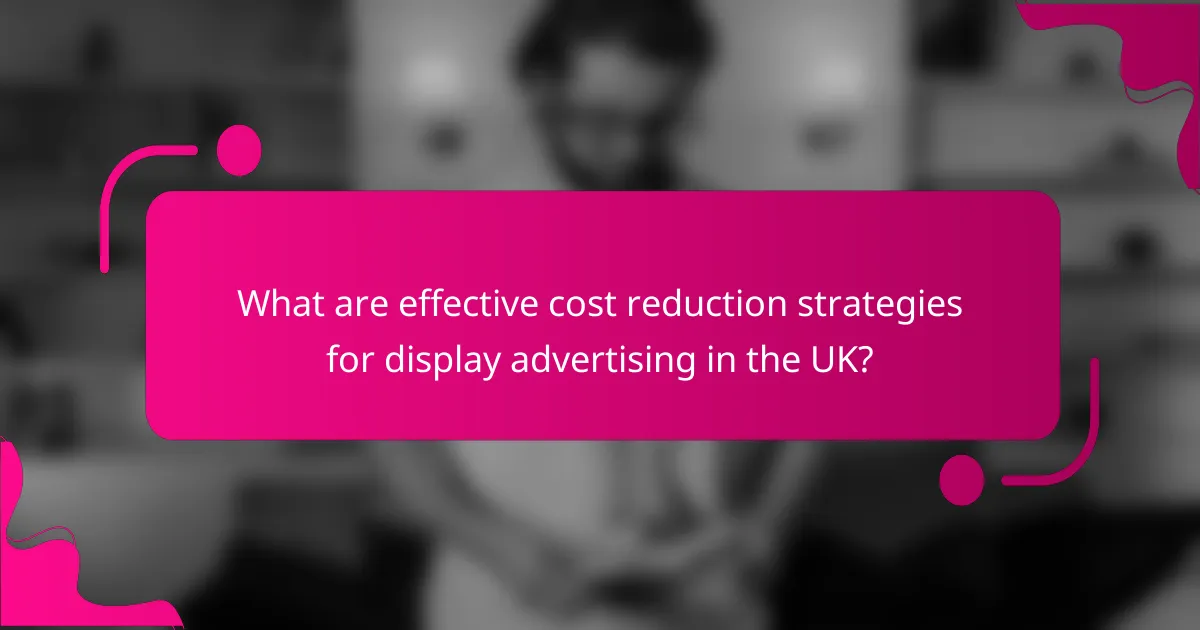In today’s competitive landscape, effective cost reduction strategies for display advertising are essential for maximizing reach while minimizing spend. By harnessing technology and data-driven insights, businesses can optimize their marketing efforts to target the right audience efficiently, ensuring better results at lower costs.

What are effective cost reduction strategies for display advertising in the UK?
Effective cost reduction strategies for display advertising in the UK focus on maximizing reach while minimizing expenditure. By leveraging technology and data-driven insights, advertisers can optimize their campaigns to achieve better results at lower costs.
Programmatic advertising optimization
Programmatic advertising optimization involves using automated technology to buy and sell ad space in real-time. This approach allows advertisers to target specific audiences more efficiently, reducing wasted impressions and costs. Utilizing demand-side platforms (DSPs) can help streamline this process.
To optimize programmatic campaigns, regularly analyze performance metrics and adjust bidding strategies based on real-time data. This can lead to improved return on investment (ROI) and lower overall spending.
Audience targeting refinement
Refining audience targeting ensures that ads reach the most relevant users, which can significantly lower costs. By utilizing data analytics, advertisers can segment their audience based on demographics, interests, and behaviors, allowing for more precise targeting.
Consider using lookalike audiences to expand reach while maintaining relevance. This strategy can help in acquiring new customers similar to existing ones, ultimately enhancing campaign effectiveness without increasing spend.
Ad placement analysis
Conducting thorough ad placement analysis helps identify which platforms and placements yield the best results. By evaluating performance across different channels, advertisers can allocate budgets more effectively and eliminate underperforming placements.
Regularly review metrics such as click-through rates (CTR) and conversion rates to determine the most cost-effective placements. This ongoing analysis allows for informed decisions that can lead to substantial cost savings.
Creative asset reuse
Creative asset reuse involves repurposing existing ad creatives for new campaigns, reducing the need for constant new content creation. This strategy not only saves costs but also maintains brand consistency across different advertising efforts.
When reusing assets, ensure they are updated to fit the current campaign objectives and audience preferences. This can involve minor adjustments rather than complete overhauls, making it a cost-effective approach.
Performance tracking and adjustment
Performance tracking and adjustment are crucial for identifying what works and what doesn’t in display advertising. By continuously monitoring key performance indicators (KPIs), advertisers can make data-driven adjustments to optimize their campaigns.
Implementing A/B testing can help determine the most effective ad variations, allowing for real-time adjustments that enhance performance while minimizing unnecessary spending. Regular reporting and analysis should be part of the campaign management process to ensure ongoing cost efficiency.

How can businesses maximize reach while minimizing spend?
Businesses can maximize their reach while minimizing spending by strategically utilizing available resources and data. This involves implementing cost-effective marketing strategies that leverage analytics and digital platforms to target the right audience efficiently.
Utilizing data-driven insights
Data-driven insights allow businesses to understand customer behavior and preferences, enabling them to tailor their marketing efforts. By analyzing trends and patterns, companies can focus their resources on high-impact strategies that yield better results.
Consider using tools like Google Analytics or social media insights to gather relevant data. This information can help identify which campaigns are most effective and where to allocate budget for maximum reach.
Common pitfalls include relying on outdated data or failing to adjust strategies based on real-time feedback. Regularly reviewing and updating your data analysis can prevent wasted spend and improve overall campaign performance.
Leveraging social media platforms
Social media platforms offer a cost-effective way to reach a broad audience. By creating engaging content and utilizing targeted advertising, businesses can connect with potential customers without significant financial investment.
Focus on platforms that align with your target demographic. For instance, Instagram and TikTok are effective for younger audiences, while Facebook may be better for reaching older consumers. Experiment with different types of content, such as videos or polls, to see what resonates best.
To maximize effectiveness, avoid over-promoting products. Instead, aim for a balance of informative, entertaining, and promotional content to keep your audience engaged and willing to share your posts.

What role does audience segmentation play in cost reduction?
Audience segmentation is crucial for cost reduction as it allows businesses to tailor their marketing efforts to specific groups, thereby maximizing efficiency and minimizing waste. By understanding the distinct characteristics and preferences of different segments, companies can allocate resources more effectively and improve their overall return on investment.
Improved targeting accuracy
Improved targeting accuracy means that marketing messages reach the right people at the right time. By segmenting audiences based on demographics, behaviors, or interests, businesses can create more relevant campaigns that resonate with specific groups. This targeted approach reduces the likelihood of spending on broad, ineffective advertising.
For instance, a company selling outdoor gear may target young families with children for camping products, while focusing on adventure seekers for hiking equipment. This ensures that marketing budgets are spent on audiences most likely to convert, enhancing overall cost efficiency.
Higher engagement rates
Higher engagement rates result from delivering tailored content that speaks directly to the needs and desires of segmented audiences. When consumers feel that a message is relevant to them, they are more likely to interact with it, leading to increased conversions and lower customer acquisition costs.
For example, personalized email campaigns that cater to specific interests can achieve open rates significantly higher than generic messages. Businesses should consider testing different approaches within segments to identify what resonates best, ensuring that marketing efforts yield the highest possible engagement without overspending.

What are the prerequisites for implementing cost reduction strategies?
To effectively implement cost reduction strategies, businesses must first assess their current financial situation and operational efficiency. Understanding existing expenditures and identifying areas for improvement are crucial steps in maximizing reach while minimizing spend.
Understanding current advertising spend
Analyzing current advertising spend involves reviewing all marketing expenses to identify where money is being allocated. This includes digital ads, print media, and promotional events. Businesses should categorize these expenses and evaluate their effectiveness in driving customer engagement.
Consider using a simple spreadsheet to track monthly advertising costs against performance metrics like customer acquisition and conversion rates. This will help highlight which channels provide the best return on investment and where cuts can be made without sacrificing reach.
Setting clear performance metrics
Establishing clear performance metrics is essential for measuring the success of cost reduction strategies. Metrics should align with business goals and include key performance indicators (KPIs) such as return on ad spend (ROAS), customer lifetime value (CLV), and engagement rates.
Regularly review these metrics to ensure they reflect current market conditions and business objectives. Adjusting strategies based on performance data can help optimize spending and improve overall effectiveness. Aim for a balance between cost efficiency and maintaining brand visibility in the market.

How can businesses measure the effectiveness of cost reduction strategies?
Businesses can measure the effectiveness of cost reduction strategies by analyzing key performance indicators (KPIs) such as return on ad spend (ROAS) and customer acquisition cost (CAC). These metrics provide insights into how well a company is optimizing its spending while maximizing its reach and impact.
Return on ad spend (ROAS) analysis
ROAS measures the revenue generated for every dollar spent on advertising. To calculate ROAS, divide the total revenue from ads by the total ad spend. A ROAS of 4:1, for example, indicates that for every dollar spent, four dollars in revenue are generated.
When analyzing ROAS, consider the industry benchmarks, as they can vary significantly. For many sectors, a ROAS of 3:1 or higher is often considered effective. Regularly tracking this metric helps identify which campaigns are performing well and which may need adjustments.
Customer acquisition cost (CAC) tracking
CAC represents the total cost of acquiring a new customer, including marketing expenses, sales team costs, and other related expenditures. To find CAC, divide the total costs associated with acquiring customers by the number of new customers gained in a specific period.
A lower CAC indicates more efficient marketing strategies. Businesses should aim for a CAC that is significantly lower than the lifetime value (LTV) of a customer to ensure profitability. Regularly reviewing CAC helps businesses refine their marketing approaches and allocate resources more effectively.

What tools can assist in cost reduction for display advertising?
Several tools can effectively assist in cost reduction for display advertising by optimizing ad spend and improving targeting. Utilizing platforms like Google Ads Manager and Facebook Ads Manager can help advertisers maximize their reach while minimizing costs through data-driven strategies and precise audience targeting.
Google Ads Manager
Google Ads Manager is a powerful tool that allows advertisers to manage their display advertising campaigns efficiently. It offers features such as automated bidding strategies, which can help reduce costs by optimizing bids based on performance metrics. Advertisers can set specific goals, like maximizing clicks or conversions, to ensure their budget is spent effectively.
To further cut costs, consider using audience targeting options, such as remarketing lists and in-market audiences. These features allow you to focus on users who are more likely to convert, thereby increasing the return on investment (ROI) for your ad spend. Regularly reviewing performance data can also help identify underperforming ads that may need adjustment or removal.
Facebook Ads Manager
Facebook Ads Manager provides robust tools for managing display ads across Facebook and Instagram, enabling advertisers to reach a vast audience. The platform’s detailed targeting options allow you to narrow down your audience based on demographics, interests, and behaviors, which can lead to more efficient ad spending.
Utilizing A/B testing within Facebook Ads Manager can help identify which ad creatives and placements perform best, allowing for more strategic budget allocation. Additionally, setting a daily or lifetime budget can help control spending, ensuring that you do not exceed your financial limits while still achieving your advertising goals.
